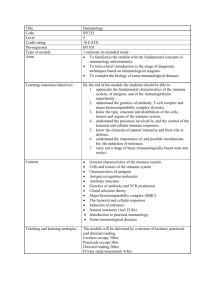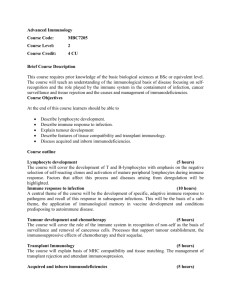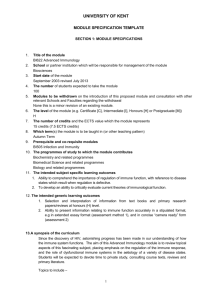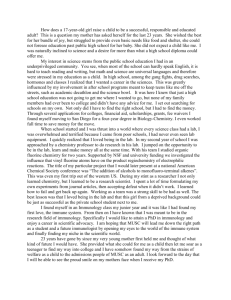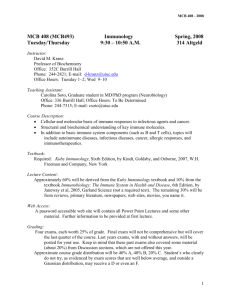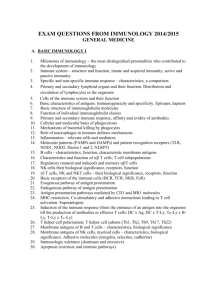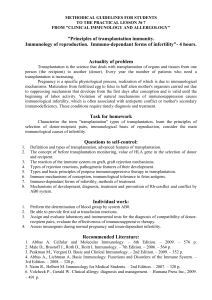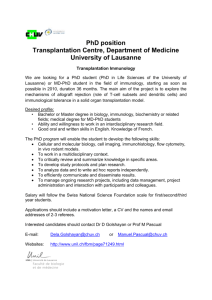The immunological problems of transplantation
advertisement
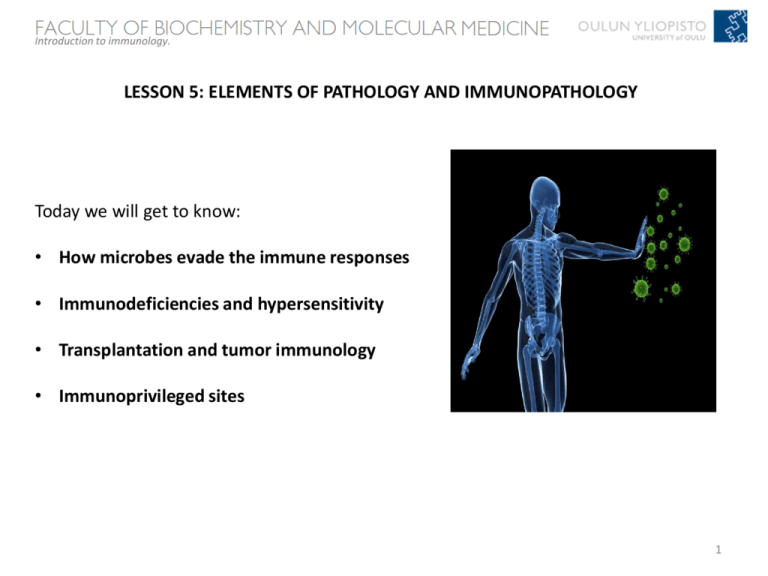
Introduction to immunology. LESSON 5: ELEMENTS OF PATHOLOGY AND IMMUNOPATHOLOGY Today we will get to know: • How microbes evade the immune responses • Immunodeficiencies and hypersensitivity • Transplantation and tumor immunology • Immunoprivileged sites 1 Introduction to immunology. Lesson 5 Microbial immunoevasion Microbes are living organisms, subjected to natural selection. Hence, evolution positively selects those microorganisms which are able to evade the immune response and successfully replicate in the host. Extracellular microbes tend to decrease their antigenicity and the possibility to be recognized and killed by humoral immunity, while intracellular microbes tend to suppress killing mechanisms of phagocytes. EXTRACELLULAR MICROBES MECHANISMS EXAMPLES Inhibition of phagolysosome formation M. Tuberculosis, L. Pneumophila ROS neutralization (phenolic glycolipids) M. Leprae Destruction of phagosome membrane (Listeriolysin) L. Monocytogenes MECHANISMS EXAMPLES Antigen variation N. Gonorrhoeae, E. Coli, S. Typhimurium Complement inhibition (sialic acid) Many extracellular bacteria Resistance to phagocytosis (bacterial capsule) Pneumococcus ROS neutralization Catalase-positive Staphylococci INTRACELLULAR MICROBES 2 Introduction to immunology. Lesson 5 Microbial immunoevasion VIRUSES MECHANISMS EXAMPLES Antigenic variation (antigenic shift) Ortho- and Paramyxoviridae, Rhinoviridae, HIV Inhibition of antigen-MHC complex formation Herpes simplex Removal of MHC-I in the endoplasmic reticulum Cytomegalovirus Production of cytokine/chemokine receptors’ homologs Poxviridae (IL-1, IL-18, TNF-a, IFN-g); Cytomegalovirus (chemokines) Production of immunosuppressive cytokines Epstein-Barr virus (IL-10) Infection (and destruction) of immunocompetent cells HIV 3 Introduction to immunology. Lesson 5 Primary and secondary immunodeficiencies The frequency of circulating leukocytes is quite stable, and increases can have a physiological explanation. Conversely, decreases in WBC counts are never physiological. A deficit in WBC counts (leukopenia) can be caused by primary or secondary immunodeficiencies. PRIMARY IMMUNODEFICIENCY SECONDARY IMMUNODEFICIENCY Genetic defects in immune cells Malnutrition, tumors, drugs, viral and bacterial infections Increased susceptibility to infections and cancer 4 Introduction to immunology. Lesson 5 Primary immunodeficiencies Immunodeficiencies can affect cellular and humoral immunity mechanisms (depending on the cells involved). When both humoral and cellular defenses are involved, together with a severe defect of T-cells, they are defined as Severe Combined ImmunoDeficiencies (SCID). Those defects can be in the numbers (developmental problems).. Abbas et al. 5 Introduction to immunology. Lesson 5 Primary immunodeficiencies … or in the functions, generally impairing T-cells and phagocytes Abbas et al. 6 Introduction to immunology. Lesson 5 Primary immunodeficiencies Abbas et al. 7 Introduction to immunology. Lesson 5 Secondary immunodeficiencies Secondary (acquired) immunodeficiencies arise from problems other than genetic ones. Infections, states of malnutrition, chemo-radiotherapy etc. can result in immunodeficiencies. HIV is the etiological agent of the acquired immunodeficiency syndrome (AIDS) in humans. It efficiently infects macrophages, dendritic cells and T-cells. Nevertheless, it is not the primary infection that is really detrimental for the host! Abbas et al. 8 Introduction to immunology. Lesson 5 Secondary immunodeficiencies - AIDS The primary (acute) infection follows more or less the normal course of a viral infection. Rising of specific immunity against HIV (anti-HIV antibodies, anti-HIV CTLs) keeps the infection under control. But, since HIV “hides into leukocytes”, it never gets eradicated and becomes a latent, chronic infection that is asymptomatic. When a new infection occurs, HIV-infected leukocytes activate normally. But, their activation will instead trigger HIV replication. As viruses are produced, Tcells and APCs are destroyed and the host is unable to defend from the pathogens. Abbas et al. 9 Introduction to immunology. Lesson 5 Immune system neoplasms Transient increase in leukocyte counts has generally a physiological base (leukocytosis). But, when this increase is stable and in absence of external factors, then immune system neoplasms must be suspected. In the old classification scheme, three ”levels” were considered: • • • The course of proliferation: CHRONIC (slow and indolent) or ACUTE (fast and aggressive) The site involved: the blood (LEUKEMIA) or the lymph nodes (LYMPHOMAS) The cell type (franco-american-british [FAB] classification) In 2001, the WHO has reorganized the classification with much emphasis on the cell type and the presence of mutations as the basis for proliferation. Also, the category of myeloproliferative-myelodysplastic (normal vs defective differentiation of myeloid cells) has been introduced. 10 Introduction to immunology. Lesson 5 Immune system neoplasms – overview of WHO classification 11 Introduction to immunology. Lesson 5 Autoimmune disorders and hypersensitivity The goal of the immune system is to discriminate self vs non self. To ensure protection of host cells, self cells must be recognized as “friends” and left unharmed (TOLERANCE). But, sometimes the immune system turns against self cells. This results in autoimmune disorders. Also, sometimes the immune response is “too big” and damages the host. This results in hypersensitivity. Defects in self-tolerance Excessive immune reactions AUTOIMMUNE DISORDERS HYPERSENSITIVITY 12 Introduction to immunology. Lesson 5 Tolerance and autoimmune disorders and hypersensitivity Many mechanisms in the body check that T- and B-cells do not react against self markers. T-cells (in the thymus) and Bcells in the bone marrow are tested against self antigens Autoreactive T- and B-cells in peripheral tissues are under the control of APCs and Treg cells If they react, their development is stopped and cells die by apoptosis If they react in absence of APCs, they become anergic (non-responsive) and die by apoptosis. Treg cells also suppress them spontaneously CENTRAL TOLERANCE PERIPHERAL TOLERANCE 13 Introduction to immunology. Lesson 5 Autoimmune disorders When tolerance is broken, immune cells can attack and destroy host cells. Generally, this depends on genetic defects of immune cells, which might be clinically unnoticed until external factors stimulate the immune response and problems arise. Autoimmune disorder Mutations Mechanisms Systemic lupus erythematosus (SLE) HLA-DR2 and DR3 haplotypes, complement deficits, FcgRIIB mutations, IFN-a and TLR polymorphisms. Autoreactive B- and T-cells attack self cells, multi-organ problems, circulating antibodies can form immunocomplexes which cause problems in the kidneys Rheumatoid arthritis Excessive production of proinflammatory cytokines (IL-1, TNF-a, IL-17, IL-6, IFN-g), excessive RANK production. Over-activated T-cells stimulate chronic inflammation of the joints which results in tissue destruction. Auto-antibodies are also present. Multiple sclerosis HLA-DR2 haplotype, viral proteins similar to neuronal myelin, CD25 polymorphisms. Th1 and Th-17 cells specific against myelin of neurons. Extensive destruction of nerves leads to paralysis and death. 14 Introduction to immunology. Lesson 5 Autoimmune disorders Autoimmune disorder Mutations Mechanisms Type-I diabetes mellitus HLA-DR3 and DR4 haplotypes, IL2 and CD25 polymorphisms, Coxsackie B4 virus Th cells and CTLs recognize antigens from pancreatic b cells (including insulin) and destroy them. Crohn’s disease and ulcerative colitis Defects in defensins and NOD2 receptor determining overproliferation of the intestinal flora, defects in autophagy genes, excessive Th17 responses maybe due to defective Tsuppressor cells. Excessive inflammatory reactions occurring spontaneously in the whole span of the intestinal mucosa (Crohn’s disease) or in colon’s mucosa (ulcerative colitis), destroying the mucosal tissue. 15 Introduction to immunology. Lesson 5 Hypersensitivity Hypersensitivity occurs when uncontrolled, excessive reactions are directed against foreign antigens, resulting in host damage. Hypersensitivity disorders are classified according to the principal immunological mechanism which determines damages to the host. 16 Abbas et al. Introduction to immunology. Lesson 5 Hypersensitivity – the example of Type I reactions Type I hypersensitivity is also called immediate hypersensitivity, allergy or atopy. These reactions only occur in some individuals in response to foreign antigens for whom the individuals have been already exposed. Immediate hypersensitivity depends on Th2-induced release of IgE by B-cells which, in turn, super-activate mast cells with consequent excessive release of histamine and other vasoactive molecules. In some individuals, the encounter with some antigens (like the pollen) strongly triggers a Th2 response in the mucosae. Under Th2 influence, B-cells undergo isotype switch and produce IgE, which bind to FceRI on mast cells. Mast cells, thus, acquire the ability to autonomously react against the allergen. Mast cells are ready to respond (still they are not “firing”) SENSITIZATION STEP Abbas et al. 17 Introduction to immunology. Lesson 5 Hypersensitivity – the example of Type I reactions When sensitized individuals encounter again the allergen, their mast cells will start producing high amounts of vasoactive amines, prostanoids, lytic enzymes and cytokines Mucosae are affected by vessel leakage and chronic inflammation Abbas et al. 18 Introduction to immunology. Lesson 5 Hypersensitivity – the example of Type I reactions The overall marker of Type I hypersensitivity is that they are immediate, meaning that the onset is extremely rapid. In some cases, they can be lethal if immunosuppressive drugs are not administered immediately. In 1989, Strachan proposed the “hygiene hypothesis”. After several revisions, the general idea is that with increasing hygienic standard, children are no more exposed to some pathogens, especially parasitic helminthes. Thus, the Th2 response (developed to face helminthic infections) becomes useless and “left uncontrolled”. This re-directs Th2 responses against non-harmful allergens. Abbas et al. 19 Introduction to immunology. Lesson 5 Hypersensitivity – Type II reactions Type II are autoimmune reactions determined by autoantibodies. These auto-IgM and autoIgG bind to self antigens of the extracellular matrix or on cell surface, triggering inflammation and damage of host tissues. Sometimes, antibodies are against bacterial structures which are very similar to self antigens (which thus get involuntarily involved). Examples of Type II include Grave’s disease (autoimmune thyroiditis), myasthenia gravis, insulin-resistant diabetes etc. 20 Introduction to immunology. Lesson 5 Hypersensitivity – Type III reactions Type III are systemic diseases caused by antibodies bound to antigens (immunocomplexes) which, being too many, are not efficiently cleared from our body. Thus, immunocomplexes deposit in the vessels and in the kidney, determining occlusions and chronic inflammation under the vessels and in organs’ parenchyma. Examples of Type III include SLE, post-streptococcal glomerulonephritis, serum sickness (immune reaction against animal antisera for toxins and venoms), etc. 21 Introduction to immunology. Lesson 5 Hypersensitivity – Type IV reactions Type IV are autoimmune reactions determined by excessive T-cell sensitivity to certain antigens. Almost all autoimmune reactions which we have already discussed involve, at least partially, Type IV reactions. A particular case of Type IV reactions is Delayed-Type Hypersensitivity (DTH), where hyper-sensitive T-cells get “activated” by a first encounter with the antigen (this is not pathological yet) and super-respond when the antigen is met again (this is pathological). Hyper-response generally takes 24-48 hours to establish (hence the name delayed). A practical use of DTH is the tuberculin skin reaction. 22 Introduction to immunology. Lesson 5 The immunological problems of transplantation Transplantation is the procedure by which cells, tissues and organs are excised from a donor and integrated in a receiver. If the object of transplant is blood or plasma then is defined as transfusion. Transplantation of cells, tissues and organs within the same individual AUTOLOGOUS TRANSPLANTATION Transplantation of cells, tissues and organs within individuals of the same species HETEROLOGOUS TRANSPLANTATION Syngeneic or Allogeneic Transplantation of cells, tissues and organs within individuals of different species XENOLOGOUS TRANSPLANTATION 23 Introduction to immunology. Lesson 5 The immunological problems of transplantation When foreign cells are transplanted into a receiver, non-self (allogeneic) MHC molecules are recognized by the receiver’s immune system. Activation of receiver’s immune system will lead to rejection. T-cells can recognize alloantigens (non-self MHC molecules) either on the surface of donor’s APCs or, more widely, if self-APCs capture non-self MHC by any type of cell in the transplant. Also humoral immunity can play a big role in transplant recognition and rejection. Abbas et al. 24 Introduction to immunology. Lesson 5 The immunological problems of transplantation When a transplant is recognized as “non self”, rejections occurs. From the hystopathological point of view, three types of rejection can occur: HYPERACUTE REJECTION (minutes/hours after transplantation) Pre-existing antibodies of the receiver recognize MHC on donor’s endothelial cells -> vascular thrombosis ACUTE REJECTION (1 week to 3 months after transplantation) T-cells and B-cells recognize non-self MHC and start to develop adaptive immunity against the transplanted tissue -> CTL kill non-self cells, Ig induce thrombosis CHRONIC REJECTION (many months to years after transplantation) Mechanisms are not fully understood, the clinical manifestation is similar to atherosclerosis 25 Introduction to immunology. Lesson 5 The immunological problems of transplantation - GVHD To ensure successful transplantation, compatibility must be checked: this means that donors and receivers must have haplotypes as close as possible. Also, immunosuppressive drugs must be given to the receiver to minimize rejection. Nowadays, most of the rejections are due to chronic reactions. A particular form of rejection is Graft Versus Host Disease (GVHD). GVHD can happen when sufficient amounts of donor’s immune cells are present in the transplanted tissue (as in the case of bone marrow transplantation). In this case, donor’s T-cells recognize recipient’s immune cells (and other cells) by the so-called minor histocompatibility antigens and attack them. 26 Introduction to immunology. Lesson 5 The immunological problems of transplantation - transfusions and the AB0 system All RBC in the blood have a particular carbohydrate (linked to proteins and lipids) on their surface called antigen H. In A individuals, antigen H is modified by an enzyme and a GalNac residue is added (antigen A). In B individuals, a Gal residue is added instead (antigen B). In 0 individuals, no further modifications of antigen H occur. From the first year of life, natural antibodies from B1 cells are produced against blood antigens different from the self. If the wrong blood is transfused, hemolytic anemia (a form of hyperacute rejection) occur. 27 Introduction to immunology. Lesson 5 The immunological problems of transplantation – the Rh disease during pregnancy Fetal blood passes to the mother through placental circulation Mother gets sensitized with fetal blood during birth processes Mother develops anti-Rh antibodies, able to pass the placenta and lyse fetal RBCs Anti Rh antibodies are already present during the 1st pregnancy, but they generally do no harm to the fetus (IMMUNOPRIVILEGE) 2nd From the pregnancy onwards, maternal memory B-cells will immediately activate and produce anti-Rh Ig, extremely dangerous for the fetus. All RBC also express another series of antigens on their surface collectively called Rh blood group (including the Rh factor). An individual can either have the Rh factor or not (Rh+ or Rh-). A woman who is Rh- must expect immunological reactions against a fetus which is Rh+ (paternal allele). This is called Rh disease, it generally occurs from the second pregnancy onwards and ranges to mild disease to very severe (lethal for the fetus) conditions. Intramuscular injections of immunoglobulins against maternal anti-Rh antibodies (Rho(D) immune globulin) solve the problem. 28 Introduction to immunology. Lesson 5 The immune privilege In animal models of transplantation, reject is never observed if tissues are transplanted into the brain or in the anterior eye chamber. In 1940, Peter Medawar defined this as immunological privilege. Currently the definition of immunoprivileged sites applies to those anatomical compartments where immune responses are always avoided, because their result would always be detrimental for the host. Known immunoprivileged sites are: Peter Medawar • The brain • The anterior eye chamber • The testicle • The fetus 29 Introduction to immunology. Lesson 5 The immune privilege – the example of the fetus A fetus expresses antigens which are of both maternal and paternal origin. But, those antigens inherited from the father would be allogeneic for the mother and should be rejected. This doesn’t happen because of many mechanisms suppressing the immune responses against the fetus. Trophoblast cells singularities Lack of paternal MHC-II in mice; expression of an invariant HLA (HLA-G) in humans; lack of costimulatory molecules in humans and mice. Active T-cell suppression Expansion of Th2 clones (which inhibit pro-inflammatory Th1 clones) in mice, Expansion of Treg cells and tolerogenic DCs in both humans and mice. Immunosuppressive enzymes Elevated presence of immunosuppressive Indoleamine 2,3dioxygenase (IDO) in humans and mice, complement inhibitor (Crry) in mice 30 Introduction to immunology. Lesson 5 Cancer as an immunological problem The immune system plays a big role in clearing transformed cells before they form cancerous masses. CTLs, Th cells, B-cells and phagocytes are all involved in the anti-cancer defense. Recognition of tumors is due the adaptive immunity, thanks to the fact that tumors express a wide variety of antigens. TUMOR-ASSOCIATED ANTIGENS (TAS) Products of mutated genes Oncofetal antigens Oncoviral antigens Normal proteins, expressed in anomalous ways Tissue differentiation antigens Altered glycolipidic and glycoproteic antigens 31 Introduction to immunology. Lesson 5 Cancer as an immunological problem Tumors evade immune recognition by passive and active mechanisms: Reduction the antigenicity, either by loss of the antigens or of the MHC molecules, can make the tumor “invisible” to the immune system. Tumors are strong cytokine producers. They can release big amounts of immunosuppressive IL-10, TGF-b and also low amounts of pro-inflammatory cytokines. As a result, immune cells shut-down. But, they can also get EDITED: the tumor induces changes in immune cells’ gene expression so that those cells start to release factors which aid tumor growth and further suppress immune responses. 32
